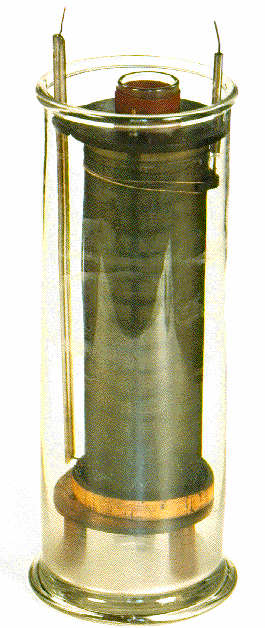 | It is a transformer created from Nikola Tesla
around
1900 in order to obtain high tensions, with low
power, in alternating
current. Consta of a cylindrical vase of glass, of 50 cm of
height and
16,5 cm of inner diameter, that contains the two
windings, secondary
head physician and, dipped in mineral oil for the isolation. The
primary one is formed with 12 coils of copper
thread, of the
diameter of 5 millimeter, wrapped over one cylindrical tube of glass of
the external diameter of 55 millimeter Has one resistance to the
clips
R1 = 0,0023 ohm and an
inductance Equal L1 to approximately 2
uH.
Secondary, the external one to the head physician, millimeter is formed
with approximately 380 coils of copper thread of the diameter of
0,2,
isolated and wrapped over a tube of cylindrical glass of 113 the
external diameter of millimeter. Ohm has a
resistance to the R2 clips
of 70 and a L2 inductance of approximately 5,5 mH. Feeding the head
physician with an oscillating circuit, constituted from a spark gap and
a condenser in series, excited in its
turn they give
a
battery or from an electrostatic generator, the tensions many elevated
to vhf and spark of remarkable length are obtained between the ends of
secondary. The frequency is between 10,5 and 10,6
Hz and it depends
from the resonance conditions of the oscillating
circuit, also the
value of the tension to the secondary one not only depends from
relationship N2/N1 between the number of
secondary and primary
coils, but also from the resonance conditions of the
circuit.
The apparatus is served, to its times, under
consideration of the
electric oscillations to vhf
and to the observation of the first
curious consequences of the skin effect.
L. Graetz: Die Elektrizitat - Engel horn,
Stuttgard, 1903, p.280 |
|

